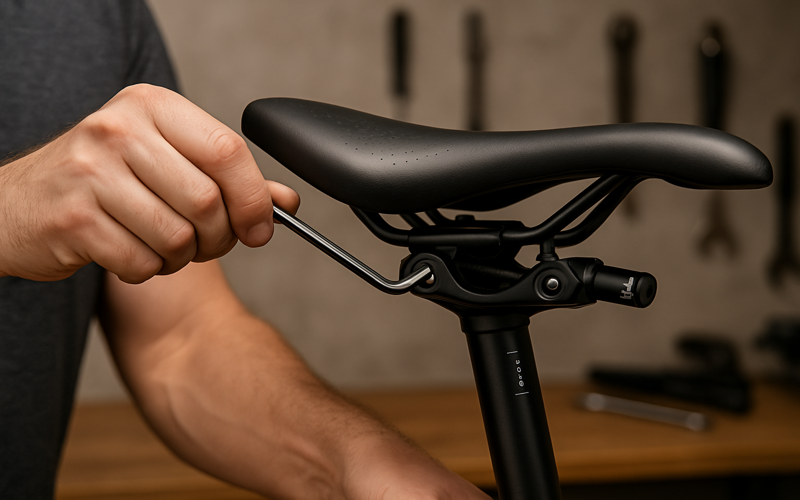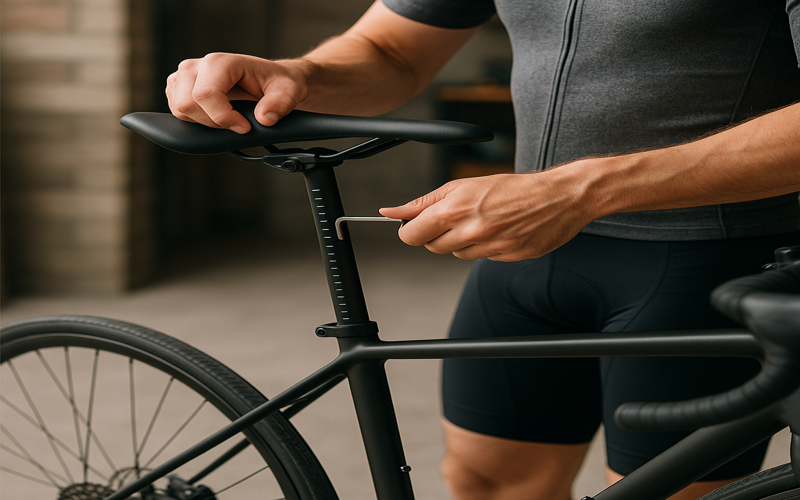1. Introduction
A well-tuned bike seat adjustment mechanism is more than just a comfort feature—it’s a crucial element for maximizing performance and preventing cycling-related injuries. Whether you’re a casual rider or a competitive cyclist, improper seat alignment can lead to pain, fatigue, and long-term joint issues.
In this guide, you’ll learn how to properly adjust your bike seat’s height, tilt, and fore-aft position using the right tools and techniques. We’ll also cover expert-backed tips to help you fine-tune your saddle for optimal power output, improved posture, and all-day riding comfort.

2. Understanding the Bike Seat Adjustment Mechanism
- The bike seat adjustment mechanism controls the positioning of your saddle in terms of height, tilt, and fore-aft movement, directly affecting rider comfort and efficiency.
- Most modern bikes use either a single-bolt, dual-bolt, or micro-adjust system for saddle adjustments.
- A bike seat height adjustment mechanism lets you raise or lower the saddle to align with your leg length for optimal pedaling power.
- The tilt mechanism allows fine-tuning of the saddle angle, which can relieve pressure on soft tissues and enhance riding posture.
- The fore-aft adjustment mechanism slides the saddle forward or backward, helping to find the correct saddle position to engage glutes and maintain joint alignment.
- Quick-release clamps are commonly found on commuter and entry-level bikes, offering fast adjustments without tools but with less precision.
- High-performance bikes often feature torque-specific seat clamps that require tools like an Allen wrench or a bike seat adjustment tool for more secure, accurate tuning.
- Understanding your seat clamp type is essential for knowing how to tighten bike seat clamps correctly and avoid saddle slippage during rides.
- Choosing the right adjustment system supports proper bike fit, improves cycling efficiency, and helps prevent lower back and knee strain.
3. Bike Seat Angle Adjustment

- Adjusting the angle of your bike seat is essential for maximizing comfort, enhancing performance, and reducing the risk of injury while riding.
- A level saddle is the standard starting point and works well for most riders, promoting even weight distribution.
- Slight downward tilt can help relieve pressure on sensitive areas during long rides but may cause sliding if over-adjusted.
- A slight upward tilt may benefit riders who prefer more pelvic support but can lead to discomfort or numbness if too steep.
- Use a bike seat adjustment tool or torque wrench to make precise angle changes based on your riding style and body mechanics.
- For road cycling or endurance riding, micro-adjustments in bike seat angle can reduce saddle soreness and improve power output.
- Check your angle regularly, especially after travel or crashes, as misalignment can affect saddle position and glute engagement.
- Incorrect saddle tilt often leads to lower back pain, hand numbness, or hip strain, indicating the need for proper adjustment.
- Combine angle adjustments with correct seat height and fore-aft positioning to achieve optimal bike
4. Adjusting Seat Height for Optimal Performance

- Proper bike seat height adjustment is key to efficient pedaling and preventing knee strain.
- Your leg should maintain a slight bend (25–30 degrees) at the bottom of each pedal stroke for ideal alignment.
- A seat that is too high can cause hip rocking and discomfort, while a low saddle reduces power output.
- Use a bike seat adjustment tool or Allen key to fine-tune seat height based on your inseam length.
- Check saddle height while wearing your usual cycling shoes to ensure realistic positioning.
- Recheck your height setting regularly, especially after transport or intense rides.
- Correct seat height supports proper saddle position to engage glutes, boosting endurance and control.
- Optimizing seat height complements other adjustments like bike seat angle and fore-aft saddle positioning.
5. Adjusting Saddle Position: Forward or Back?
- Adjusting your saddle position forward or back affects your reach, posture, and muscle engagement while cycling.
- Shifting the saddle forward shortens the distance to the handlebars and places greater emphasis on engaging the quadriceps during pedaling.
- Sliding the saddle back often promotes a more powerful pedaling position and better glute engagement.
- Proper positioning helps balance weight distribution and reduces pressure on the hands, neck, and lower back.
- Use a plumb line from the front of your knee to the pedal axle to assess neutral alignment.
- Fine-tune saddle setback based on your riding style, whether it’s road cycling, touring, or competitive racing.
- Pair this with accurate bike seat height adjustment to avoid knee pain and improve endurance.
- Always test changes during short rides to feel how adjustments impact comfort and pedaling efficiency.
6. How to Tighten Bike Seat Clamp Safely
- Begin by identifying the type of bike seat clamp—most bikes use a single or dual-bolt clamp under the saddle.
- Use the appropriate bike seat adjustment tool, typically a 5mm or 6mm Allen wrench, to access the clamp bolts.
- Ensure the saddle angle and position are correct before tightening to avoid discomfort or poor posture.
- Gradually tighten the bolts, alternating between them if dual-bolt, to ensure even clamping pressure.
- Avoid overtightening, which can damage the seatpost or saddle rails—refer to the manufacturer’s recommended torque setting if available.
- Check the seat height and alignment before the final tightening to ensure optimal fit and comfort.
- After tightening, test the saddle by pressing down and lightly rocking it to confirm it’s firmly secured.
- Regularly inspect the clamp and bolts during routine bike maintenance to prevent loosening over time.
7. Adjustments and Glute Activation
- Proper saddle height and tilt adjustments are essential to engage the glutes effectively during cycling, reducing strain on the lower back and knees.
- A neutral saddle tilt (neither nose up nor down) supports better posture and ensures balanced pressure distribution for optimal power transfer.
- Fore-aft saddle position should align the rider’s knee over the pedal spindle to maximize glute muscle recruitment and prevent over-reliance on quads.
- Ensuring correct reach and handlebar height maintains a stable core, allowing the glutes to work more efficiently during both climbs and sprints.
- Regularly assessing and fine-tuning bike fit promotes consistent glute engagement and prevents muscle imbalances over long rides.
- Incorporating glute activation exercises (e.g., bridges, clamshells) before riding enhances muscle readiness and improves pedaling efficiency.
- Riders often mistake hamstring or quad dominance for strength, but proper glute activation leads to better endurance and injury prevention.
- Using a power meter or cadence tracker helps monitor output and adjust form to ensure the glutes are contributing adequately to performance.
- Cyclists recovering from injury or with muscle compensation patterns should consider a bike fit consultation to restore glute-driven motion.
- A well-adjusted bike setup paired with glute-focused training is key to boosting cycling power, endurance, and joint longevity
8. Special Considerations for Female Cyclists
- Female cyclists often benefit from women-specific bike saddles designed to support wider sit bones and reduce soft tissue pressure.
- Pelvic structure differences require careful saddle selection and positioning to ensure comfort and prevent numbness or discomfort on long rides.
- Choosing a saddle with a center cut-out or pressure relief channel can significantly reduce perineal pressure and improve blood flow.
- Hormonal fluctuations throughout the menstrual cycle may increase sensitivity, making cushioning and saddle fit even more important for female riders.
- Proper bike fit adjustments—including saddle height, reach, and handlebar drop—are essential to prevent hip, knee, and back strain in women.
- Female cyclists are more prone to sit bone soreness if saddle width is too narrow, which can be resolved with a personalized saddle fit.
- Investing in high-quality padded cycling shorts and maintaining good hygiene reduces the risk of saddle sores and discomfort.
- Women-specific ergonomic saddle designs enhance performance by supporting efficient glute engagement and optimal pedaling form.
- Regular reassessment of saddle comfort is recommended, especially after fitness level changes, weight loss, or postpartum recovery.
- Prioritizing comfort and correct fit ensures better endurance, injury prevention, and long-term cycling enjoyment for female riders.
9. Common Mistakes to Avoid
- Choosing the wrong bicycle saddle size often leads to discomfort, poor posture, and reduced pedaling efficiency.
- Ignoring saddle height adjustment can result in knee pain, muscle fatigue, and improper glute activation.
- Tilting the saddle too far forward or backward causes pressure on the wrists or soft tissue, compromising comfort and control.
- Overlooking sit bone measurement leads to poor saddle support, especially on long-distance rides.
- Using a saddle based on appearance rather than fit and function can affect cycling performance and endurance.
- Skipping a professional bike fitting can prevent you from achieving proper alignment and optimized glute engagement.
- Neglecting routine checks and maintenance of the saddle and seat post can lead to premature wear and reduced riding stability.
- Ignoring early signs of saddle discomfort increases the risk of developing chronic issues like saddle sores or numbness.
- Believing that one saddle suits every rider overlooks the critical role of personal anatomy and unique cycling posture..
- Not experimenting with saddle angles and setback can limit power output and lead to muscle imbalances over time.
10. Conclusion
Understanding the bike seat adjustment mechanism is essential for achieving both comfort and performance on the road. A properly adjusted saddle not only supports healthy posture and efficient pedaling but also helps prevent common cycling injuries caused by poor alignment. Whether you’re a beginner or an experienced rider, learning how to fine-tune your saddle height, angle, and fore-aft position ensures a more stable and enjoyable ride. Regularly maintaining and adjusting your bike seat based on your riding style and body geometry leads to long-term comfort and improved cycling efficiency. Prioritizing correct saddle setup is a simple but crucial step toward a safer, more personalized riding experience.
11. FAQs
Why is proper bike seat adjustment important?
Proper bike seat adjustment helps ensure correct posture, reduces the risk of injury, and improves pedaling efficiency. It also enhances comfort on short and long rides.
What is the bike seat adjustment mechanism?
The bike seat adjustment mechanism refers to the system that allows you to modify the saddle’s height, tilt, and fore-aft position. It typically includes the seat post clamp, saddle rails, and adjustment bolts.
How do I know if my bike seat is positioned correctly?
A correctly positioned bike seat allows your leg to be slightly bent at the bottom of the pedal stroke. You should feel balanced, with no knee pain or excessive pressure on your hands or saddle.
Can an incorrect saddle angle cause discomfort?
An incorrectly angled bike saddle may cause discomfort such as numbness, lower back strain, or increased pressure on sensitive areas. A neutral or slightly downward tilt is often recommended for most riders.
How often should I check my bike seat adjustments?
It’s a good idea to check your seat adjustment every few weeks or after a long or rough ride. Rechecking is also important if you change shoes, pedals, or riding position.
Are there different adjustment mechanisms for road and mountain bikes?
While the basic components are similar, some mountain bikes use dropper seat posts or more rugged clamps, whereas road bikes prioritize weight and precise adjustment for endurance performance.
Can I adjust my bike seat without professional help?
Yes, most seat adjustments can be done at home using a multi-tool or Allen key. Still, getting a professional bike fit is highly advised to achieve maximum comfort and peak riding efficiency.
